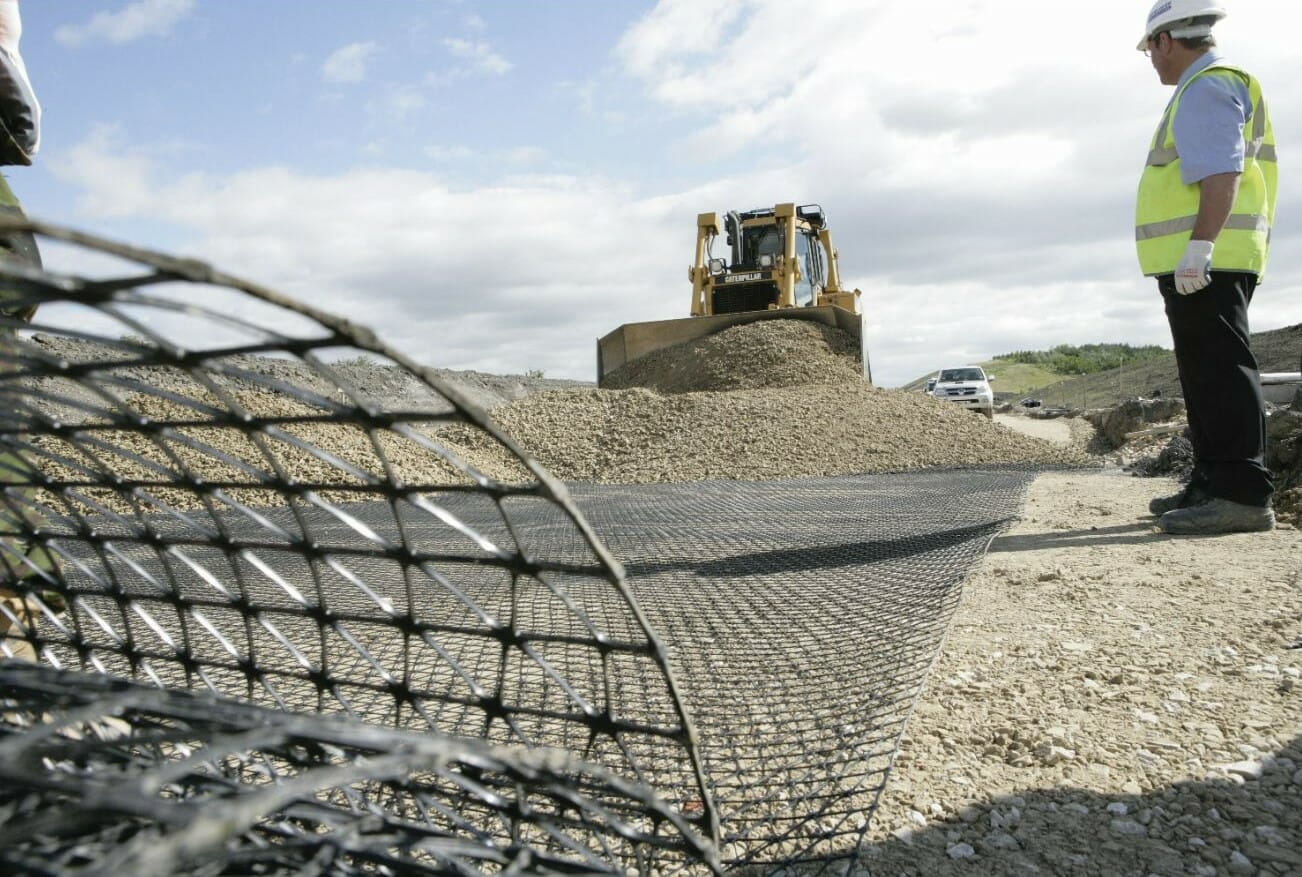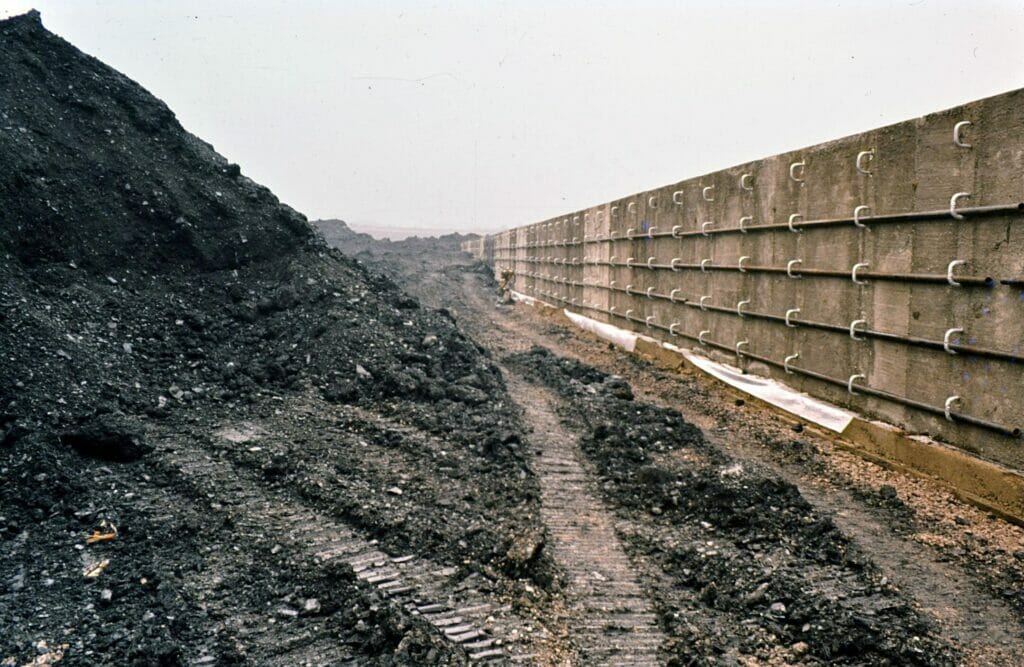
What are Geogrids and where are they used?
Geogrids are polymer products with a grid structure formed from interconnected ribs that are used to reinforce or stabilise soils and aggregates. They are widely used in reinforced soil walls and embankments and for the stabilisation of roads and trafficked areas, particularly over weak soils.
Beginnings
As with most great ideas and products that we now take for granted, geogrids started small, and have come a long way to reach the level of acceptance and usage we see today.
In the early 1970s, extruded polymer mesh structures – the brainchild of Dr Brian Mercer – were being increasingly utilised in civil engineering applications and were clearly the genesis of the geogrid. Later in the 70s, the Tensar process, whereby geogrids are formed by punching and drawing a polymer sheet, was invented by Dr Mercer. These were stronger and stiffer than the earlier meshes, making them more suited to infrastructure works, and they began to be deployed early in the 1980s. Dr Mercer continued his research and his ground-breaking work, developing more complex and effective versions of his initial designs. These early versions of stiff polymer geogrids, with integral junctions, were obviously the basis of the geogrids used so frequently cross the sector, today.
Introducing New Technology
In 1978 Mercer filed for a patent on his integral oriented polymeric grid which he called Tensar®. He also coined the word “geogrid.” The first use of geogrid in soil reinforcement was for a retaining wall at a colliery in Yorkshire supporting rail cars carrying mine waste.
Obviously, before any new technology can be accepted and used in building and construction projects, it needs to be tested and approved as safe in every way (production, development, transport, installation and long-term sustainable use). Dr Mercer entered into a number of collaborative research projects with universities to develop generate the knowledge and data necessary for design and application of geogrids in soils, roads, railways, and asphalt

Geogrids were first trialled at Silkstone Colliery, Yorkshire in 1980
First Geogrid Symposium
In 1984, a number of interested parties came together at the first geogrid symposium, to consolidate years’ of work, and share the data and information proving the safety and efficacy of this new technology. Universities, consultancy firms, research groups, local authorities, contractors and clients contributed to the growing body of knowledge and information that would enable the wider use of geogrids in practical applications.
As no test methods had been available for these new materials, new testing regimes were established, drawing on the knowledge of all these stakeholders. They developed and implemented innovative new tests to support geogrid application in walls, pavements, slopes and asphalt. Design and construction details were shared to encourage use of the materials and the new structural applications. At the 1984 symposium, the technology and its associated products – as we know it today – became recognised, and began its evolution based on this symposium, and its contributors.
Development
The next step in the development of the geogrid industry was to leverage the testing and trials data and gain acceptance – specifically, initially, formal approval by the Highways Authority, for the construction of geogrid reinforced soil walls and bridge abutments. This was begun in 1984 with the formation of a BSI committee and although an inevitable conservative leaning towards concrete, steel piling and other traditional methods continued, geogrids began to be accepted across the sector. Identifying the importance of a definitive document recognising and formalising guidance on the deployments of geogrids, a formal Code of Conduct was developed although this was to take 10 years and numerous changes in structure and direction, before the ultimate finalisation of BS8006 (1995). The publication of BS8006 began to develop credibility for geogrids and other geosynthetic products and created increased confidence across the industry, not just in vertical walls and steep slopes, but extending the applications to other reinforced soil options.
Results
Usage in the UK began to offer proven data, and positive feedback for geogrid reinforced soil structures in the US was available by the late 1980s, then internationally, recognition increased significantly following the Great Hanshin (Kobe) earthquake in 1995. Conventional, reinforced concrete structures experienced significant damage from the earthquake, which registered above 7.0 on the Richter scale. The geogrid reinforced walls, however, were the subject of numerous papers and reports, all of which agreed that this technology offered superior resilience and suffered considerably less damage.
Further development
The technology continued to evolve with further investments and innovations both in the UK and US. New products and applications were developed in the marine, mining, waste containment and other markets. Improvements were made in engineering practices and designs. For wall and slope structures, fully integrated systems are now available from Tensar that include the design and supply of geogrid reinforcement, facing components and connectors.
Over the years ongoing research, field testing and trafficking trials have expanded the base of geotechnical knowledge about the properties, performance and use of geogrids in road and rail applications. Tensar launched their new TriAx® geogrid in 2007, with its hexagonal grid structure and triangular apertures, the first geogrid developed specifically for stabilisation applications.

In 2003, the revolutionary TriAx® geogrid was patented
Design Tools and Software
As well as development of geogrid products there has been tremendous development of the tools and software available to enable engineers to design using geogrid solutions. Companies such as Tensar have developed market leading software such as TensarSoil® for the design of reinforced soil walls and steep slopes and TensarPave for pavement design and ground stabilisation.
Geogrids today
Geogrids have been used on large construction sites and prestigious projects around the world, such as the Panama Canal and the largest ports in the United States, the Channel Tunnel project, and several of the artificial mountains at Disney theme parks. Geogrids reinforce track ballast under sections of the high-speed rail system in China and support hundreds of miles of rail track in the US, Europe, Australia and Asia. Deep underground in mine shafts around the world thousands of workers are protected every day by geogrid roof support systems. Bridge abutments, retaining walls and steep stable slopes up to 60m high have been constructed with geogrid reinforced soil around the globe. Geogrids are everywhere…you just can’t see them!
Author: Jonathan Cook, Tensar
